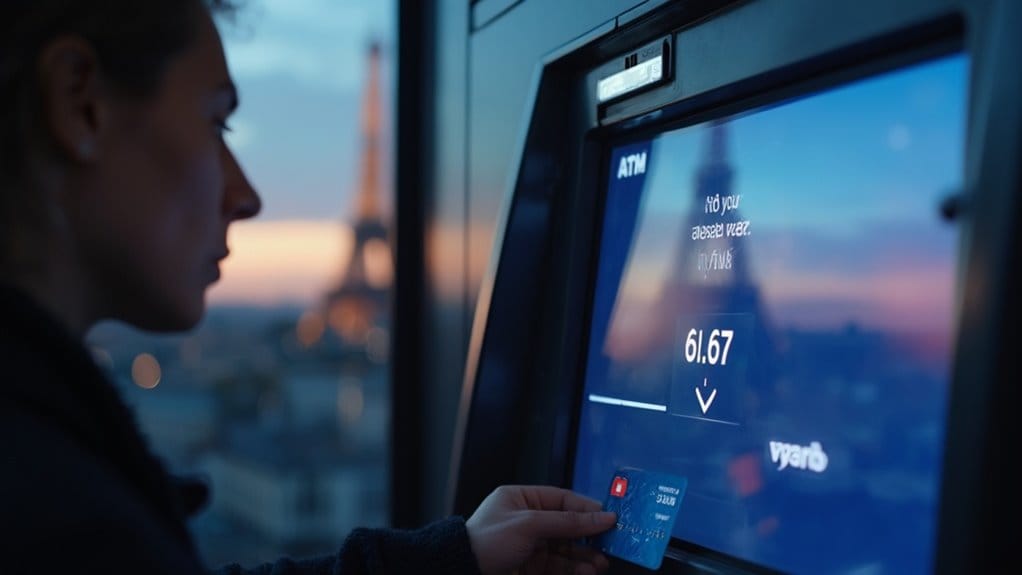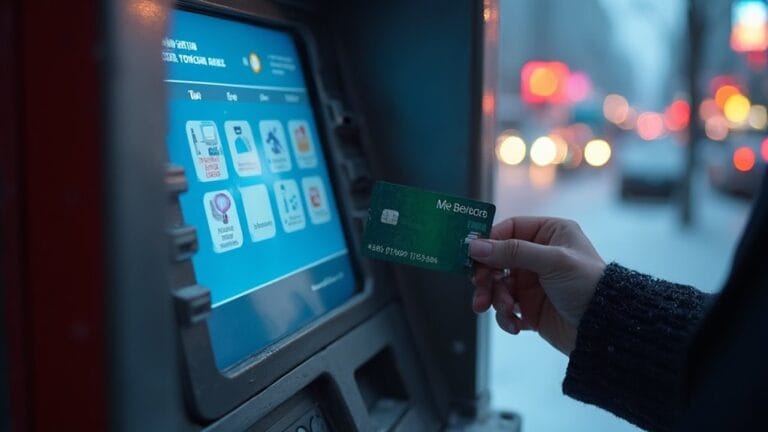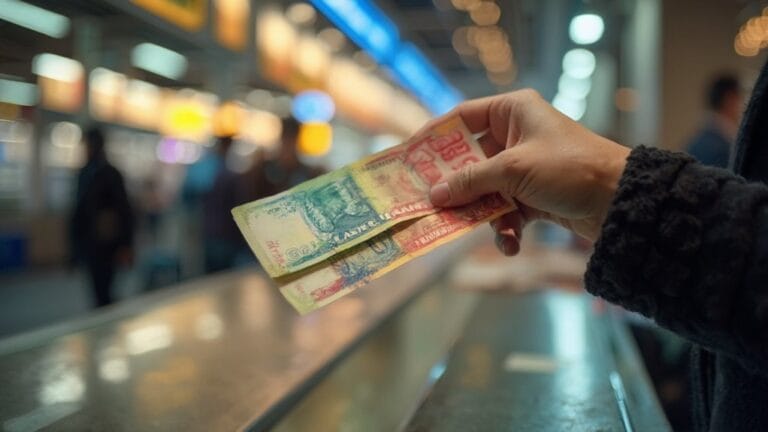You'll face high ATM fees abroad because Canadian banks stack multiple charges on international withdrawals. When you use your card overseas, you're typically hit with a currency conversion markup (2.5-3%), a flat ATM fee ($3-5), and possibly additional local ATM charges. Even with bank partnerships like Scotiabank's Global ATM Alliance, you'll still pay conversion fees on most transactions. It's a triple-whammy that can add up quickly, especially on smaller withdrawals. While some digital alternatives like Wise offer lower fees, understanding these charges helps you make smarter choices for your international money needs.
Key Takeaways
- Canadian banks face operational costs and compliance requirements when maintaining international banking partnerships and ATM networks abroad.
- Limited competition in the Canadian banking sector allows major banks to maintain high fee structures without losing customers.
- Banks apply markups of 1-3% above wholesale exchange rates to generate revenue from currency conversion services.
- Multiple parties (banks, ATM operators, payment networks) each take a cut of international transactions, resulting in layered fees.
- Risk management costs associated with international transactions in different regulatory environments contribute to higher operational expenses.
Bank Networks and Fee Structures
The landscape of Canadian bank networks and ATM fees presents a complex web of charges when withdrawing money abroad. If you're planning an international trip, you'll want to understand how your bank's network can either save you money or leave you with hefty fees that'll make your wallet cry.
Take Scotiabank, for instance – they're like that well-connected friend who knows everyone. As part of the Global ATM Alliance, you'll enjoy fee-free withdrawals at a whopping 44,000 ATMs across 40 countries. That's pretty sweet! But if you're with RBC, you're looking at $3 for US withdrawals and $5 for other countries, though they'll cut you some slack on US purchases with no foreign transaction fees. Choosing to pay in local currency instead of your home currency can help you avoid dynamic currency conversion surcharges.
For the digital-savvy folks, Wise and Koho offer modern alternatives. Wise gives you a generous $350 CAD in free monthly withdrawals before their fees kick in, while Koho's subscription plans include one free international withdrawal per month. When you're calculating total costs, remember you're usually getting hit with both flat fees (those sneaky $2-5 charges) and percentage fees (typically 1-3% of your withdrawal). It's like paying double rent – nobody wants that!
Hidden Costs of Foreign Withdrawals
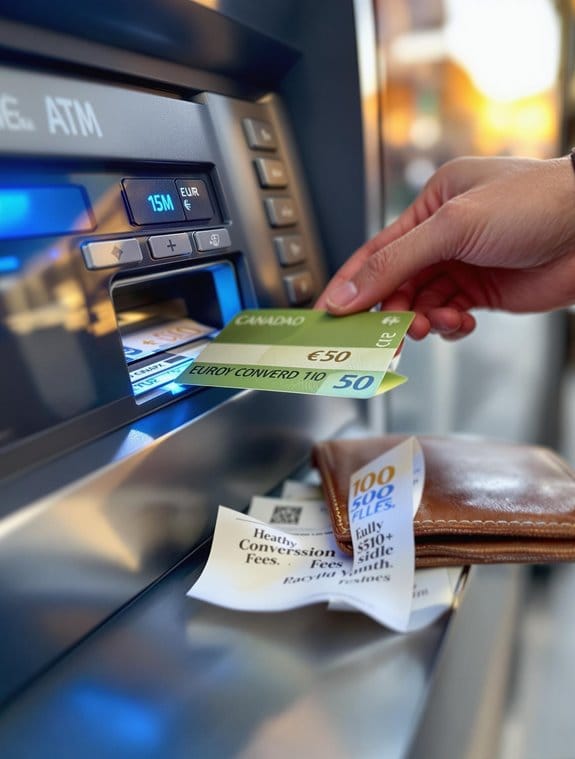
While bank networks and fee structures might seem straightforward at first glance, there's a murky world of hidden costs you'll need to watch out for when withdrawing money abroad. You might think you're only paying that $3 or $5 flat fee from your Canadian bank, but oh boy, there's more lurking beneath the surface!
First, there's that sneaky foreign transaction fee – we're talking 2.5% to 3% of your withdrawal amount that just vanishes into thin air. Then, the ATM itself might hit you with its own fee, which can range from a couple of bucks in Canada to nearly 4 euros in places like Greece. But here's where it gets really tricky: those ATMs love to offer their own conversion rates, which usually aren't in your favor. It's like they're saying, "Hey, trust us with your money!" when really, you should be running the other way. Especially watch out for Eurobank ATMs as they're known for offering particularly poor rates.
To avoid getting caught in this financial quicksand, you'll want to refuse those ATM conversion rates, stick to your bank's exchange rate, and make fewer, larger withdrawals. Think of each ATM visit as a potential money pit – the fewer trips you make, the more cash stays in your pocket!
Currency Exchange Rate Markups
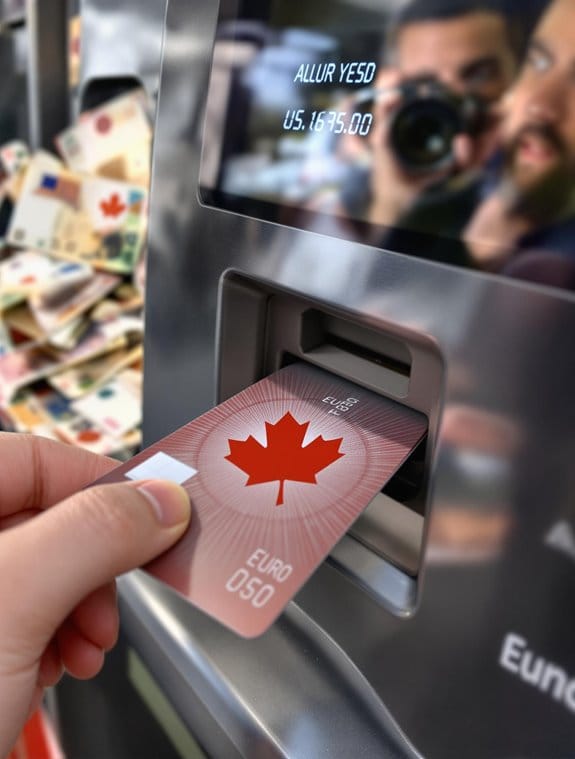
Diving into currency exchange rate markups reveals another costly aspect of foreign withdrawals. When you're dreaming of sipping coconut water on a beach in Bali, you might not realize that your bank's sneaky markup on currency exchanges could buy you an extra drink or two! Banks typically tack on 1-3% above the wholesale exchange rate, which might not sound like much until you do the math.
Let's say you're withdrawing $1,000 worth of foreign currency – that innocent-looking 3% markup from Bank of America means you're saying goodbye to an extra $30. And if you're using a TD Access Card with Visa Debit, you'll wave farewell to even more, thanks to their 3.5% fee. Most Canadian cards aren't much better, with a standard 2.5% conversion fee that'll quietly eat away at your vacation budget. You'll also face transaction fees of $5 when using ATMs outside Canada and the U.S.
But here's the good news – you're not stuck with these hefty markups! Services like Wise have revolutionized international transactions by offering considerably lower or even zero conversion fees. Before you jet off on your next adventure, you'll want to compare these options carefully – your future self (and wallet) will thank you!
Global Banking Partnership Limitations
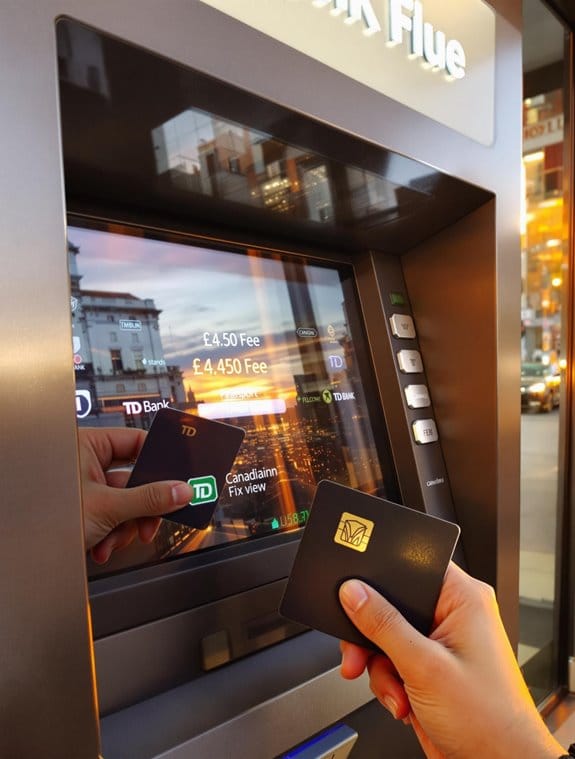
Beyond currency exchange markups, you'll want to understand how banking partnerships affect your ability to access cash abroad. These partnerships, or sometimes the lack thereof, can make a huge difference in your travel experience and wallet. While some Canadian banks have joined forces with global networks like the Global ATM Alliance, you'll find that these partnerships aren't as extensive as you might hope.
Think of it this way: your bank is like a social butterfly that's a bit nervous about making friends in certain neighborhoods. Due to risks involving compliance, reputation, and operations, many Canadian banks limit their international partnerships, especially in regions they consider high-risk. The complex nature of correspondent banking relationships requires extensive due diligence and monitoring to maintain secure cross-border transactions. You might discover that your trusted debit card becomes surprisingly less useful in some countries. For instance, while Scotiabank customers can happily withdraw cash from partner ATMs worldwide without access fees, they'll still face that pesky 2.5% currency conversion fee. Meanwhile, if you're banking with smaller institutions, you might find yourself paying both ATM surcharges and foreign transaction fees, making each withdrawal feel like a small fortune. It's worth checking your bank's global network before you travel to avoid any nasty surprises.
Alternative Payment Solutions Abroad
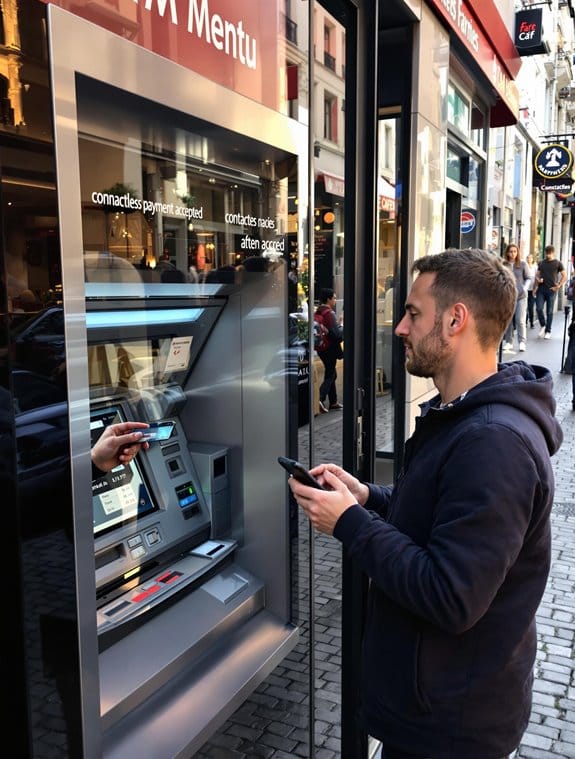
Savvy travelers are increasingly turning to alternative payment solutions to sidestep hefty ATM fees and foreign transaction charges. If you've ever felt the sting of those pesky international fees, you'll be thrilled to know there's a whole world of smart alternatives waiting for you.
You'll find that multi-currency checkout options are becoming your new best friend abroad, letting you pay in local currencies without those eye-watering conversion fees. And here's a game-changer: local payment solutions like Alipay in China or Paytm in India aren't just convenient – they're often cheaper than traditional banking options. Businesses are seeing reduced fraud risks by embracing these trusted local platforms. Remember that time you struggled with your Canadian card in Tokyo? Well, those days can be behind you.
For the tech-savvy wanderer, integrating these payment solutions is easier than ever. You might want to check out no-fee ATM cards from providers like Schwab or Fidelity (your wallet will thank you), or explore Buy Now Pay Later options for those bigger travel expenses. The best part? You're not just saving money – you're joining a global movement of travelers who've discovered that banking smarter means traveling better.
Frequently Asked Questions
Are ATM Fees Tax-Deductible When Traveling for Business Purposes?
Yes, you can deduct ATM fees when they're directly related to your business travel expenses. Just make sure you keep detailed records and receipts to document these charges for tax purposes.
Can I Dispute International ATM Charges if the Machine Malfunctions?
Yes, you can dispute ATM malfunctions abroad. Document the issue immediately, contact your bank within 10 days, and request an investigation. Keep transaction records and screenshots as evidence to support your claim.
Do Canadian Banks Offer Fee Waivers for Students Studying Abroad?
Like a cloud on a sunny day, you won't find widespread student fee waivers for international ATMs. Your best bet's using banks with global partnerships or seeking accounts that offer Allpoint/Global ATM Alliance benefits.
How Long Do International ATM Fee Refunds Typically Take to Process?
You'll typically see international ATM fee refunds within 3-10 business days, though timing depends on your bank's policies. The process might be longer during holidays or weekends when banks aren't processing refunds.
Are ATM Fees Higher During Weekends or Holidays in Foreign Countries?
While international ATM fees can reach up to 5% per transaction, you won't face higher charges specifically during weekends or holidays. The fees remain constant, though they're generally higher for international transactions year-round.

